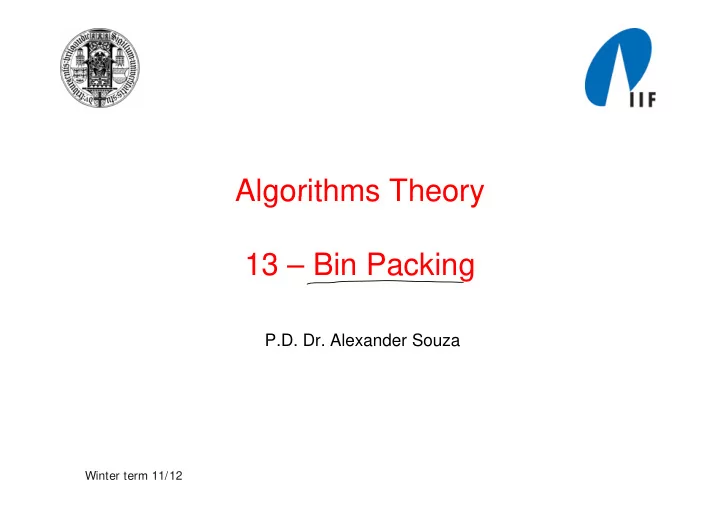

Algorithms Theory Algorithms Theory 13 13 – Bin Packing Bi P ki P.D. Dr. Alexander Souza Winter term 11/12
Bin packing 1. Problem definition and general observations 2 Approximation algorithms for the online bin packing problem 2. Approximation algorithms for the online bin packing problem 3. Approximation algorithms for the offline bin packing problem pp g p g p 2 Winter term 11/12
Problem definition Given: n items with sizes s 1 , ... , s n where 0 < s i ≤ 1 for 1 ≤ i ≤ n . Goal: Goal: Pack items into a minimum number of unit-capacity bins. Example: 7 items with sizes 0.2, 0.5, 0.4, 0.7, 0.1, 0.3, 0.8 3 Winter term 11/12
Problem definition Online bin packing: Online bin packing: Items arrive one by one. Each item must be assigned immediately to a bin, without knowledge of any future items. Reassignment is not allowed. Offline bin packing: All n items are known in advance, i.e. before they have to be packed. 4 Winter term 11/12
Observations • Bin packing is provably hard Bin packing is provably hard. (Offline bin packing is NP-hard. Decision problem is NP-complete.) • There exists no online bin packing algorithm that always finds an optimal solution. ti l l ti 5 Winter term 11/12
Online bin packing Theorem 1: Theorem 1: There are inputs that force each online bin packing algorithm to use at least 4/3 OPT bins where OPT is the minimum number of bins possible. P Proof: f Assumption: online bin packing algorithm A always uses less than 4/3 OPT bins 4/3 OPT bins 1 1/2 1/2 ..... .... 0 1 1 2 m m + 1 m + 2 2 m 2 m + 1 m + 2 2 m m time 6 Winter term 11/12
Online bin packing 1st point of time: 1st point of time: OPT = m /2 and #bins( A ) = b by assumption: b < 4/3 ⋅ m /2 = 2/3 m Let b = b 1 + b 2 , with L t b b + b ith b 1 = #bins containing one item b 2 = #bins containing two items #bins containing two items b 2 There is: b 1 + 2 b 2 = m , i.e. b 1 = m –2 b 2 Hence: b = b 1 + b 2 = m – b 2 ( ∗ ) 7 Winter term 11/12
Online bin packing 2nd point of time: 2nd point of time: OPT = m #bins( A ) ≥ b + m – b 1 = m + b 2 Assumption: m + b 2 ≤ #bins( A ) < 4/3 m b 2 < m /3 < /3 b using ( ∗ ): b = m – b 2 > 2/3 m using ( ): b m 2/3 m b 2 8 Winter term 11/12
Online bin packing Next Fit (NF), First Fit (FF), Best Fit (BF) Next Fit: Assign an arriving item to the same bin as the preceding item If it does Assign an arriving item to the same bin as the preceding item. If it does not fit, open a new bin and place it there. Theorem 2: (a) For all input sequences I : NF ( I ) ≤ 2 OPT ( I ) NF ( I ) ≤ 2 OPT ( I ). (b) There exist input sequences I such that: NF ( I ) ≥ 2 OPT ( I ) – 2. ( ) ( ) 9 Winter term 11/12
Next Fit Proof: (a) Proof: (a) Consider two bins B 2k-1 , B 2k , 2 k ≤ NF ( I ). 1 0 B 1 B 2 B 2k-1 B 2k 10 Winter term 11/12
Next Fit Proof: (b) Proof: (b) Consider an input sequence I of length n p q g ( n ≡ 0 ( mod 4)): 0.5, 2/ n , 0.5, 2/ n , 0.5, ... , 0.5, 2/ n Optimal packing: Optimal packing: 1 2/n 0.5 0.5 0.5 .......... 2/n 0.5 0.5 0.5 2/n 0 B 1 B 2 B n/4 B n/4 + 1 11 Winter term 11/12
Next Fit Next Fit yields: Next Fit yields: 1 2 /n .......... 2 /n 2 /n 0.5 0.5 0.5 0 B 1 B 2 B n/2 NF ( I ) = NF ( I ) OPT ( I ) = 12 Winter term 11/12
Recommend
More recommend